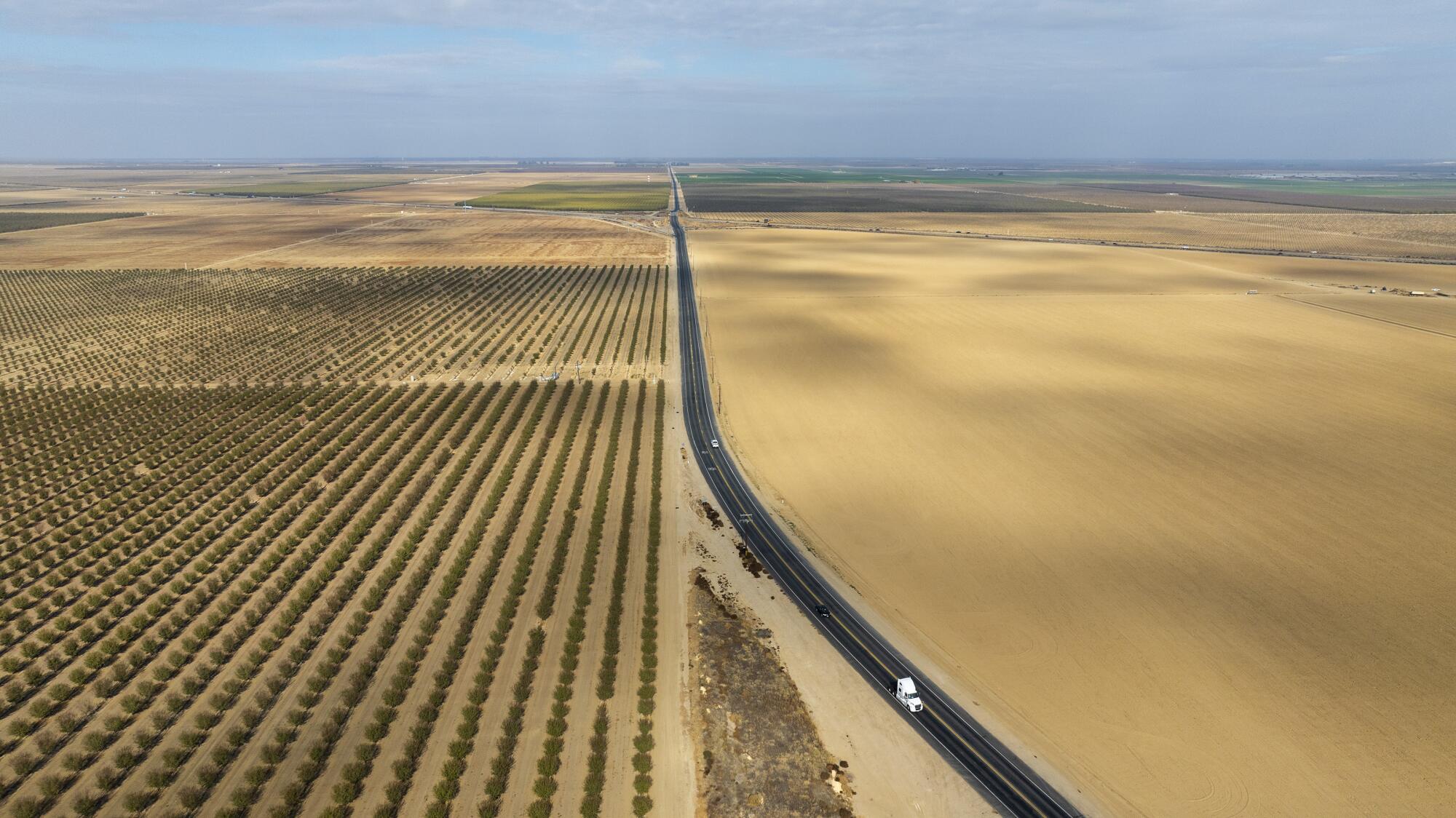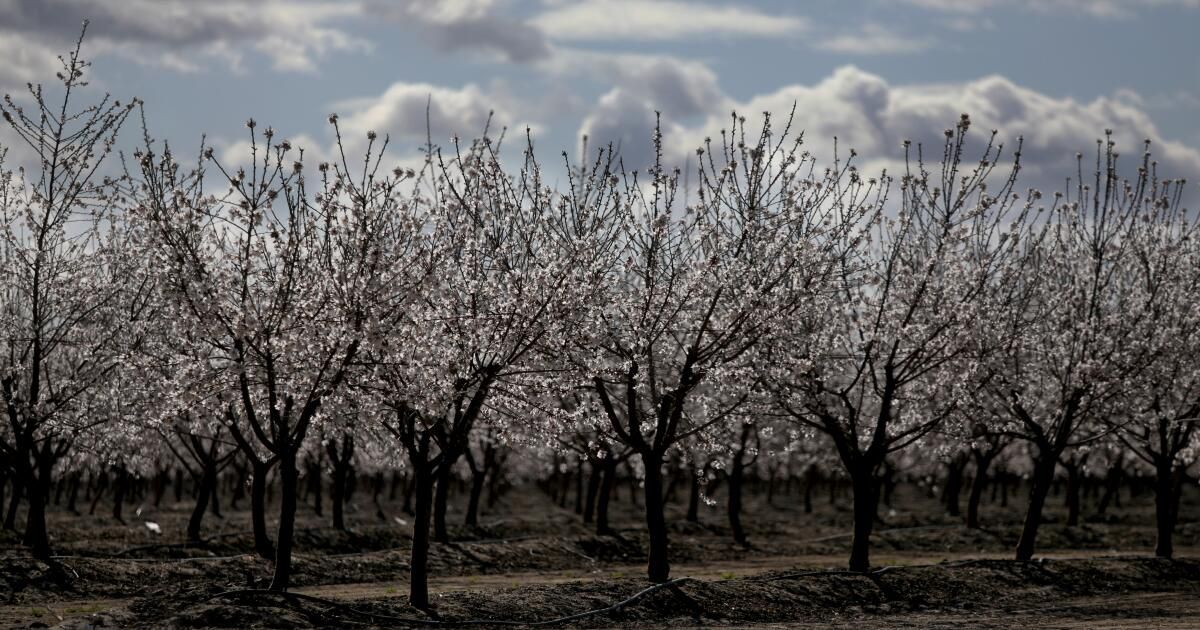For much of the last decade, almonds have been such a lucrative crop that growers and investment firms have poured money into planting new orchards across vast stretches of California farmland.
Now, the almond boom has fizzled out and the industry has entered a recession. Prices have dropped in recent years and the state's total almond acreage has begun to decline as growers have begun tearing out orchards and planting other crops.
Aggressive and impactful reporting on climate change, the environment, health and science.
In a sign of the problems plaguing the industry, a large almond-producing conglomerate filed for bankruptcy.
In a series of Chapter 11 filings in federal bankruptcy court, Trinitas Farming and other affiliated companies said record high almond prices and high interest rates contributed to their “severe liquidity constraints.”
The group of companies said in a court document filed Feb. 19 that they own 7,856 acres of almond orchards in five counties, including Solano, Contra Costa, San Joaquin, Fresno and Tulare. As part of the bankruptcy proceedings, these orchards are expected to be put up for sale.
“When the price is low, we start to see results. And certainly the fear is that Trinitas is the tip of the iceberg,” said Jake Wenger, general manager of Salida Hulling Assn., which runs an almond shelling plant in Modesto.
Prices for premium almonds have fallen from nearly $4 a pound a decade ago to about $2 a pound or less, Wenger said. Although low prices are affecting all producers, those who are being especially affected are the many groups of investors who bought land when prices were high and now have large debts, he said.
“The question is: Do some of these banks apply for some of these loans? And that will really be a concern for a lot of people in the industry,” Wenger said. “No one got more into debt with the banks than many of these investor groups.”

A road in Buttonwillow, California, bisects the farm fields of Kern County, with a large almond orchard to the left.
(Brian van der Brug/Los Angeles Times)
The group that filed for bankruptcy includes Trinitas Advantaged Agriculture Partners IV, LP, an investment fund formed and managed by Redwood City-based Trinitas Partners, a private equity investment firm. It also includes the investment fund subsidiary Trinitas Farming, based in Oakdale, and 17 other subsidiaries.
Lawyers for the group said in court documents that the investment fund was organized by Trinitas Partners in 2015 to develop and operate almond farms in the Central Valley. He said the companies were “well positioned to become profitable businesses” but were ultimately “unable to raise the necessary capital” through investments or potential asset sales. The reported debts of the entities total approximately $180 million.
Trinitas Partners itself was not among the companies that filed for bankruptcy. Representatives for the companies did not respond to requests for comment on the matter.
“I really strongly believe that they will not be the only ones facing financial difficulties,” Wenger said.
Low prices seem to make some investments difficult to make. Wenger and others in the almond business have noticed some abandoned orchards in parts of the Central Valley over the past year, with rows of neglected trees now overgrown with weeds.
“We are already seeing people moving away,” Wenger said.
He said he believes almond prices will eventually recover, but it's unclear when that change might occur.
“I certainly don't think we've seen the worst yet,” Wenger said.
While several factors have contributed to the situation, Wenger and others say some of the problems weighing on prices include an oversupply of almonds after years of rapid growth.

A farmer examines a clump of almonds in an orchard in Manteca, California, in June 2022.
(Paul Kuroda / For The Times)
California produces about 80% of the world's supply of almonds. And according to federal data, harvested almond orchards in the state have skyrocketed from 760,000 acres in 2011 to more than 1.3 million acres in 2022.
However, over the past two years, annual orchard mapping has shown that California's total almond acreage has begun to decline.
Over the past decade, the almond boom has coincided with growing concerns about water in California. When growers and investment companies bought land and drilled wells to pump groundwater in the Central Valley, expanding nut orchards blocked long-term water demands and increased pressure on the state's declining aquifers.
Wenger said he thinks it's possible that if some of these orchards stop producing, groundwater levels could rise in some places.
“It depends on the cropping patterns that are adopted and what happens next,” he said. “But it has the potential that we could see benefits to groundwater.”
Critics who have questioned the amount of water devoted to growing almonds include Bill Maher, who recently drew laughs on his show when he urged Gov. Gavin Newsom to “take on Big Almond.”
The environmental group Food and Water Watch has also urged the state to limit the expansion of almond orchards and other water-intensive crops, such as alfalfa. Chirag Bhakta, the group's California director, said the almond expansion “has locked us into a situation where we are growing too many of these thirsty nuts in parts of California,” compounding the problems of excessive groundwater pumping. .
Bhakta said it's difficult to know whether the bankruptcy case points to more future problems in the industry. But he said it represents an “opportunity for us to change what has been grown on that land to really reflect what is best for California” and the state's water needs.
Almond industry representatives have defended the crop's water use, pointing to agricultural statistics that show almonds cover 21% of irrigated farmland in California, but account for 14% of agricultural water use. They have also observed that, in addition to nuts, almond shells are used to feed livestock.
In the coming years, California's agricultural industry will face water limits under the requirements of the state's 2014 Sustainable Groundwater Management Act. The law requires local agencies in many areas to develop plans to curb excessive pumping by 2040.
Researchers at the Public Policy Institute of California have estimated that addressing the groundwater deficit in the San Joaquin Valley will likely require taking at least half a million acres of farmland out of production, and have called for expanded efforts to help convert agricultural lands into other uses, such as solar development or habitat areas.
In addition to water limitations, the almond industry has faced other challenges, including tariffs in China and other countries, as well as shipping bottlenecks during the COVID-19 pandemic.
“There's been a glut in the almond market for a couple of years,” said Caity Peterson, associate director of the Water Policy Center at the Public Policy Institute of California.
“We may have reached peak almonds,” Peterson said. “The industry will probably right-size so that supply better meets demand and there is not oversupply, as we have now.”
Some experts say the almond industry is likely to recover. Analysts at Rabobank wrote in an analysis this month that “a strong rebound in almond prices is expected over the next 12 to 18 months.”
International markets have a great influence. According to the most recent harvest data for the 12 months ending July 2023, 72% of the state's almonds were exported, while 28% were sold domestically.
California's total almond acreage has declined over the past two years primarily due to declining new plantings, said Rick Kushman, spokesman for the California Almond Board.
“The orchards last about 25 years and then the producers replant them, if they so decide. Financing may have been harder to come by and is likely more expensive now,” Kushman said in an email. “Shipping has been strong in recent months, but we are a long way from seeing if that will affect planting decisions.”
There are approximately 7,600 almond farms in the state and about 70% of the state's orchards are less than 100 acres, according to the California Almond Board.
Wenger said those best prepared to weather this type of crisis are family businesses that own their land debt-free.
Almond growers are not the only ones in agriculture who have had to deal with difficult economic conditions.
“Nut prices are terrible. Grape prices are terrible,” Wenger said. “Pistachios are not doing very well. “So we have all these crops that are starting to suffer.”
The decline of the Trinitas almond business comes after recent news that large fruit producer Prima Wawona also filed for bankruptcy.
Some producers in the San Joaquin Valley have chosen to replace almond trees with pistachio orchards.

Flowers fill the branch of an almond tree in an orchard near Sanger. California produces about 80% of the world's supply of almonds.
(Gary Coronado/Los Angeles Times)
Still, most of California's almond orchards remain, and almond trees have been blooming with white and pink flowers in the Central Valley.
“Agriculture in general is going through very difficult times,” said Bill Lyons, a Stanislaus County farmer who once served as state agriculture secretary under Gov. Gray Davis.
On their family's century-old ranch, they run a livestock operation and grow a wide variety of crops.
“We have been in the almond business for over 25 years and are seeing record low prices for several years and very high expenses,” Lyons said. “And when you combine the two, it is extremely difficult for any almond farmer to make a profitable living.”
He said when some homeowners have abandoned their trees, it's a problem for neighboring growers because unattended orchards can harbor pests, such as orangeworm, that can spread to nearby orchards.
Lyons said his family plans to continue growing almonds.
“Hopefully, the price of almonds will gain momentum,” Lyons said. “I have confidence in the almond industry, but it will definitely be a major bump in the road going into next year.”
Times staff writer Kevin Rector contributed to this report.












